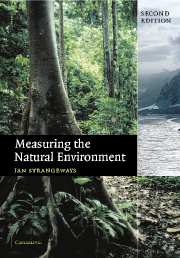Book contents
- Frontmatter
- Contents
- Acknowledgements
- 1 Basics
- 2 Radiation
- 3 Temperature
- 4 Humidity
- 5 Wind
- 6 Barometric pressure
- 7 Evaporation
- 8 Precipitation
- 9 Soil moisture and groundwater
- 10 Rivers and lakes
- 11 Data logging
- 12 Telemetry
- 13 Visibility
- 14 Clouds
- 15 Lightning
- 16 The upper atmosphere
- 17 The oceans
- 18 Cold regions
- 19 Remote sensing
- 20 Atmospheric composition
- 21 Forward look
- Appendix: abbreviations and acronyms
- Index
- References
20 - Atmospheric composition
Published online by Cambridge University Press: 05 July 2014
- Frontmatter
- Contents
- Acknowledgements
- 1 Basics
- 2 Radiation
- 3 Temperature
- 4 Humidity
- 5 Wind
- 6 Barometric pressure
- 7 Evaporation
- 8 Precipitation
- 9 Soil moisture and groundwater
- 10 Rivers and lakes
- 11 Data logging
- 12 Telemetry
- 13 Visibility
- 14 Clouds
- 15 Lightning
- 16 The upper atmosphere
- 17 The oceans
- 18 Cold regions
- 19 Remote sensing
- 20 Atmospheric composition
- 21 Forward look
- Appendix: abbreviations and acronyms
- Index
- References
Summary
Generally the atmosphere is hazy: and this is caused by the falling of impalpably fine dust, which we found to have slightly injured the astronomical instruments. The morning before we anchored at Porto Praya, I collected a little packet of this brown-coloured fine dust. … The dust falls in such quantities as to dirty everything, and to hurt people's eyes. … Professor Ehrenberg finds that this dust consists in greater part of infusoria with siliceous shields … and has ascertained no less than sixty-seven different organic forms!
Charles Darwin Voyage of the Beagle (Cape de Verd Island).This chapter is not as detailed as the previous ones. In part this is because most of the instruments used are largely of the industrial type, pressed into the service of environmental monitoring and, being very specialised, would require too much space to do them justice; nor is such a description really necessary. Also in the sections on total ozone and ozone profiles, the techniques have already been covered in Chapters 16 and 19 and it would be tedious to repeat it all. Readers should refer to these chapters for the detail of the methods.
The variables and their measurement
Earth's atmosphere is composed of 78% nitrogen, 21% oxygen and 0.9% argon. The remaining 0.1% is made up of carbon dioxide (0.036%), hydrogen, ozone, carbon monoxide, helium, neon, krypton and xenon in more or less fixed quantities, and water vapour in amounts that vary greatly. In addition, there are very small amounts of other, trace, gases measured in parts per million (ppmv, etc., where v indicates that the ratio is by volume) and parts per billion or trillion. It is these trace gases, and atmospheric particulate matter, that are the topic of this chapter, more specifically those that are generated by, or are affected by, human activities.
- Type
- Chapter
- Information
- Measuring the Natural Environment , pp. 503 - 518Publisher: Cambridge University PressPrint publication year: 2003



